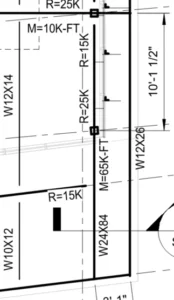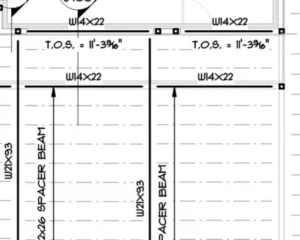Better Structural Drawings for Steel Connections
Why Your Drawings Matter More Than You Think
Delegated connection design offers benefits: faster schedules, specialized expertise, and cost savings. However, many engineers of record (EOR) unknowingly create drawings that lead to expensive problems. Missing reactions, unclear scope definitions, and poor communication turn an efficient process into a costly series of requests for information (RFIs), delays, and over-designed connections.
When connection designers receive incomplete information, they default to assumptions that can significantly raise fabrication costs.
Advantage Structural Engineers’ structural drawing guide provides the essential information needed for safe and efficient delegated connection design.
Understanding Your Audience and Scope
Successful EORs recognize that connection designers are partners, not just vendors executing tasks. This mindset changes how you approach drawing preparation.
Clearly Define the Connection Design Scope
Define what falls under delegated design using the American Institute of Steel Construction (AISC) Code of Standard Practice Options 1, 2, or 3. Your drawings must clearly communicate which connections are included and which remain your responsibility.
Common confusion arises around stability connections, hangers, and specialty connections. These gray areas generate expensive RFIs when not addressed upfront. Include a clear scope statement on your drawings that eliminates ambiguity about what’s included.

This plan shows a heavily loaded beam-over-column connection without a perpendicular stability bracing connection. The connection is susceptible to kickout and collapse.
Treat Connection Designers as Team Members
View connection designers as team members rather than external contractors. This collaborative approach encourages open communication and leads to more efficient designs that benefit everyone, from the fabricator’s bottom line to the owner’s project budget.
Essential Drawing Requirements
Provide Specific, Realistic Reactions
The biggest mistake EORs make is omitting reactions or providing generic reaction tables. When you don’t specify actual reactions, connection designers must use inflated default values that can be four to five times higher than necessary.
Instead of generic inflated reactions, provide complete reaction information:
- Include actual calculated reactions for each connection point, with both magnitude and direction
- At moment connections, clearly label governing load combinations. Provide a gravity and lateral combination for a complete design envelope.
- Extract values directly from your structural analysis software rather than using estimates
- Including reactions can also provide a level of quality control for the EOR’s drawings and review process. The potentially disastrous issue shown in the figure below could have been avoided if the structural drawings had included reactions.

This plan shows a heavily loaded W21 beam framing into a W14 beam. The project contained a generic load table with small W14 reactions. Advantage caught this issue and notified the EOR. Otherwise, this could have been a disaster.
Use Consistent Load Designation Standards
Ensure that everyone knows whether you’re using ASD (Allowable Stress Design) or LRFD (Load and Resistance Factor Design). Outdated terms, like “factored” and “service” loads, can create confusion about which design approach to use. Clearly label your reactions as either “ASD loads” or “LRFD loads.”
Define Lateral Load Paths
Connection designers need to understand how lateral forces move through a structure. Don’t leave connection designers guessing.
- Clearly identify collector elements
- Show how lateral loads move through a structure
- Include axial reactions in collector beams
- Specify which connections must transfer these forces
Best Practices with Connections
Shear Connections
Avoid forcing a specific type of shear connection onto a fabricator. Some fabricators prefer bolted single angles while others prefer shear plates. Provide reactions and allow the connection designer to design connections that are most suitable and work best for the fabricator.
Look for conditions like small beams framing into large girders and beam framing in at acute angles that can lead to large copes requiring member reinforcement. Deepen beams in this condition to allow for more efficient connections.
Moment Connections
Moment forces can act in two directions. Where moment connections occur on each side of a column, different strength checks may be governed by gravity combinations and lateral combinations. Provide the governing gravity and lateral reactions to allow the designer to design this connection fully.
Column concentrated force checks often fail at moment connections when these are delegated. EORs should check columns for moment forces and upsize to eliminate costly doublers and stiffeners where possible. AISC’s Clean Columns Excel spreadsheet, Column Analysis & Design, is a quick and effective way for EORs to check columns and select column sizes.
Brace Connections
Brace connections become complicated due to the way forces are transferred through the system. Make sure you’re clear about the implications of the uniform force method and any special requirements for base plate connections. Keep in mind that you’re still responsible for how steel connects to concrete foundations.
Consider connection geometry and member types to create efficient brace connections. Use Wide Flange columns at highly loaded braces, and orient the column in the weak axis when possible. Place work points at the top of base plates to streamline the flow of forces through a base connection.
Communication and Collaboration
Build Direct Communication
The best delegated design projects happen when EORs and connection designers communicate clearly. Don’t rely on drawings alone to convey complex details about projects. Pick up the phone or schedule a brief kickoff meeting.
Connection designers often see patterns you might miss. When they suggest a different connection type that performs the same but costs less, pay attention. They’re not trying to change your design. They’re trying to make it work better.
Set Clear Expectations Early
Establish any details at the beginning of the design process:
- What connection types do you prefer, and what won’t work because of architectural or structural issues
- Any special requirements like fire ratings, aesthetic concerns, or owner preferences that affect connection choice
- Understand submittal timeline with respect to the coordination with and expectations of the delegated designer
- Who to communicate with when technical questions come up
- Performance requirements beyond the basic structural loads that might influence connection selection
At Advantage Structural Engineers, we begin every project by looking at the entire picture. We identify potential issues, determine what additional information we need, and initiate conversations that lead to more efficient designs.
Next Steps to Better Connection Design
Creating better structural drawings for delegated connection design requires attention to detail, clear communication, and a collaborative mindset. As the EOR, you are responsible for connection performance, thorough drawings, and proactive communication.
The investment in detailed drawing preparation pays dividends through reduced RFIs, faster schedules, and more economical connections. When you provide connection designers with complete, accurate information upfront, you enable efficient solutions that benefit everyone involved.
In our next post, we’ll take a deeper dive into the importance of open dialogue in the delegated design process and the consequences of poor communication.
